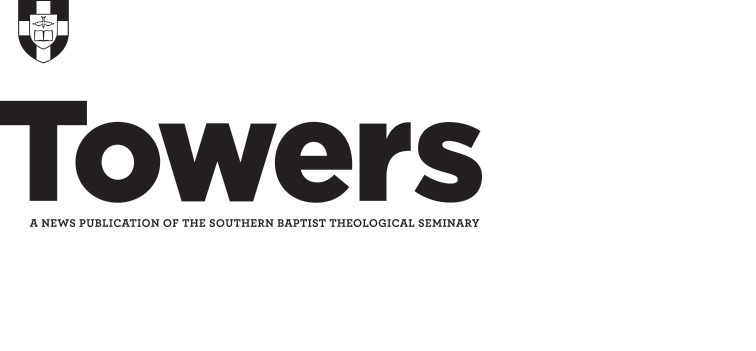Among the many treasures held by the James P. Boyce Centennial Library and Archives, the oldest and possibly the most distinguished is a fragile medieval codex, originally acquired by Adolf Deissmann, professor of philology at the Humbolt University of Berlin. In the aftermath of World War I, Deissmann had campaigned vigorously to protect the ancient city of Ephesus from unnecessary decay and destruction.1 In the autumn of 1926, during his excavation at Ephesus, Deissmann met a Turkish dealer who possessed a previously unknown Greek codex of the four Gospels; he promptly purchased it.
Deissmann, seizing the opportunity to provide his work with further funds, offered to sell the manuscript to A.T. Robertson for $700. In a letter dated March 2, 1927, he wrote to Robertson, “I did not offer the codex to anyone else, you are the first whom I informed about this chance. If you’re interested I suppose you may find some patronage as I did in 1910.”2 Robertson indeed found willing financial supporters, and with great excitement he purchased the manuscript.3 He believed that it could be the second-most important Greek New Testament manuscript housed in an American library. In Robertson’s initial estimation, only Codex Washingtonianus, a fifth-century Gospel codex, was more valuable than the one he was purchasing for his seminary.4
As soon as the manuscript arrived from Turkey, Robertson gave it to his student John W. Bowman to photograph. Bowman considered this gesture “generosity for which there is certainly little precedent.”5 Bowman undertook the task of photographing and analyzing the Gospel of Mark portion for his Ph.D. dissertation.6 At the time, only five complete manuscripts of the New Testament had been photographed.7 The task of photographing the manuscript, lasting from June 27 to September 16, 1927, was largely one of trial and error. Bowman, who had limited experience with photography, had to travel to the Kodak factory in Rochester, New York, in order to gain the proper camera, chemicals, and apparatus for securing the manuscript while the photos were being taken.8 The dark vellum, stained with age, made photographing the manuscript — so as to make the script legible — very difficult. With perseverance Bowman was able to provide images that “proved to be more legible than the original itself!”9
Deissmann had originally asked Robertson not to publish the particulars on how the manuscript was obtained, in fear that the Turkish government’s knowledge of the transaction could jeopardize his own work in the region.10 By the time Bowman published his findings in 1927, the secretive nature of the provenance was apparently no longer needed. In Bowman’s The Review and Expositor article, the details about the manuscript exceed what Deissmann had originally permitted.11
The manuscript contains Matthew 9:33b-11:14a; 15:8-26:71; 27:32-28:20; Mark 1:34-4:3; 4:37-5:12; 5:30-6:16a; 6:30-16:20; Luke 1:1-3:8; 3:25-24:53; and John 1:1-7:23; 7:41-12:30. The 175 leaves (350 pages) of the manuscript, written on front and back, are roughly 7 inches tall and 5 inches wide.12 The codex was mishandled for several years prior to its acquisition, making the outer pages almost illegible. It is not surprising that the first nine chapters of Matthew and last nine of John are missing.
The manuscript — dubbed Codex Robertsonianus by Bowman — dates from the 11th century, and most likely predates the Crusades.13 It is indicative of the kind of sacred texts used in poorer churches and monasteries around the Black Sea in the late Middle Ages.14 The script of the manuscript is of the minuscule type, written in lowercase Greek with a conservative style.15 The manuscript has lectionary markings on 65 pages, indicating that it was used in corporate worship. These notations are written in a much larger script than the main text of the manuscript.16
Bowman, commenting on the historical and scholarly value of Codex Robertsonianus, felt that manuscripts of that era were “on the whole, of more interest from the standpoint of the history of the transmission of the sacred text than as guides to what is original and pure.”17 Codex Robertsonianus seems to be representative of the Byzantine family of New Testament manuscripts, a family of manuscripts fairly unified in their texts. This family of manuscripts later became the textus receptus, the Greek New Testament used in the translation of the King James Version. Although earlier manuscripts of the New Testament are now available to scholars in the field of text criticism, Codex Robertsonianus still provides a valuable portal into the history of the transmission of our sacred scriptures.
The photographic copies of the Codex Robertsonianus are available for viewing in the Archives and Special Collections office at the James P. Boyce Centennial Library.
Endnotes
1 Gerber, Albrecht, Deissmann the Philologist, (New York: De Gruyter, 2010), 155-206. Gerber does not record Deismann’s selling of the manuscript, which he discovered during the 1926 excavation.
2 A.T. Robertson Papers, Box 7, Folder 3, Archives and Special Collections, James P. Boyce Centennial Library, The Southern Baptist Theological Seminary, Louisville, Kentucky.
3 Bowman, John W., “The Robertson Codex,” The Review and Expositor 26 (1929):175.
4 Robertson, A.T., “A Newly Discovered Tetra-Euangelion,” The Review and Expositor 25 (1928):80. Codex Washingtonianus is held by the Smithsonian in Washington D.C in the Freer Gallery of Art.
5 Ibid., 174.
6 Bowman, John W., “The Robertson Gospels: Codex 2358” (Ph.D. Diss., The Southern Baptist Theological Seminary, 1930).
7 Bowman, John W., “The Robertson Codex,” The Review and Expositor 26 (1929):176.
8 Ibid., 178.
9 Ibid., 179.
10 Adolf Deissmann to A.T. Robertson May, 30th 1927. A. T. Robertson Papers, Box 7, Folder 3, Archives and Special Collections, James P. Boyce Centennial Library, The Southern Baptist Theological Seminary, Louisville, Kentucky.
11 Bowman, John W., “The Robertson Codex,” The Review and Expositor 26 (1929):171-196.
12 Ibid., 182-184.
13 Codex Robertsonianus is the honorary title Bowman desired the codex to have after his mentor.
14 Ibid., 182.
15 Ibid., 188.
16 Ibid., 188.
17 Ibid., 195.




